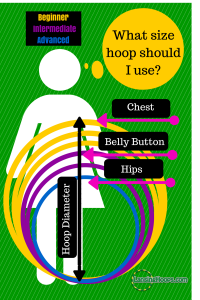Think you want to try hoop dance but haven’t learned how to hoop on your waist yet?
You’re not alone!
Waist hooping requires moving your body in ways you’re probably not used to…and sometimes it feels a little bit weird at first. It’s definitely worth it to push through because once you get it down you’ll find that hula hooping is excellent stress relief. Watch the video below to learn how to waist hoop today!
Learn How to Waist Hoop
1. Use the Right Size Hoop
Many people believe a small light hoop is good for a beginner, but actually the opposite is true. A larger heavier hoop takes longer to rotate in a circle, giving you more time to make your body do what it needs to do to keep the hoop up. Adult beginner size hula hoops range in size from 38-42″ in diameter, and weigh between 1-2 pounds.
Think about it like this. If you wear an adult size 7, you wouldn’t try to wear a child’s size 7 just because it was the same number, right?
Hoops work the same way. You might be able to waist hoop with something smaller, but it won’t be easy…or comfortable.
2. The Hoop Moves Where You Move
If you want to learn how to hoop on your waist, it’s important to remember that the hoop moves where you do. Try watching yourself in a mirror. It’s common for beginners to see a lot of movement in their neck, shoulders, and knees. If this happens, straighten your spine so that your head, neck, and shoulders are in line with your hips and knees.
Now wind up and spin the hoop around your waist, focusing on the part of your body where you want the hoop to rotate.
3. Push, Don’t Spin.
Even though it’s called “hula hooping”, your hips don’t rotate in a circle. Instead, your hips and waist are pushing back and forth as the hoop makes contact with your sides. This “pulsing” motion is what keeps the hoop moving in a circle.
To keep the hoop up, make sure you keep your core engaged, but responsive. Your muscles should be tight and focused, but not rigid.
4. Take It Easy
If you find yourself “fighting” the hoop, stop and remember the basics.
- Are your abs and back engaged?
- Is your spine straight?
- Is your body moving where you want the hoop to rotate?
It doesn’t take a lot of energy or force to keep the hoop moving. When your body tenses up it’s harder to respond to the hoop and it will probably fall. To avoid this, just relax and take it easy.
It might take some time to learn how to hoop on your waist, but you will be glad you stuck with it. Before you know it, you will feel the Zen state all those hoopers rave about.

